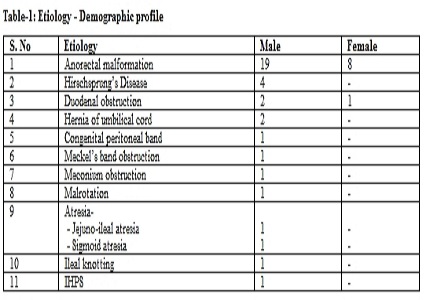Spectrum of neonatal surgical emergency- a study in rural area tertiary care center of western U.P
Abstract
Introduction: Neonatal Intestinal obstruction is commonest surgical cause in emergency, in which rapid intervention is required to prevent undesirable side effect of obstruction that includes death. This study provides spectrum of intestinal obstruction in neonates and sex prediction.
Material and Method: This is prospective study done in neonates with feature of intestinal obstruction attending emergency and outdoor of Pediatrics Surgery, Pediatrics Medicine and General Surgery of U.P.U.M.S , Saifai, Etawah during period of January 2016–December 2016.
Result: During the study period of one year total 44 patents admitted to our side with features of neonatal obstruction in which male female ratio was 3.8:1. Out of these 44 neonates Anorectal malformation was found in 61.36% neonates, Hirschsprung’s Disease in 9.09%, Duodenal obstruction in 6.81%, Hernia of umbilical cord in 4.54%, Atresia in 4.54, Congenital peritoneal band in 2.27%, Meconium obstruction in 2.27%, Malrotation in 2.27%, Meckel’s band obstruction in 2.27%, Ileal knotting in 2.27%, Idiopathic hypertrophic pyloric stenosis (IHPS) in 2.27%.
Conclusion: Early identification and surgical management in neonatal intestinal obstruction decrease morbidity and motilities in neonates. Reason of male sex predominance is not known, it may be due to less attention towards female child by social custom in our society.
Downloads
References
2. Glasser J G. Intestinal Obstruction in the Newborn [internet]. 2016 March 17; Available from: http://emedicine.medscape.com/article/2066380-overview#showall
3. Weaver LT, Steiner H. The bowel habit of young children. Arch Dis Child. 1984 Jul;59(7):649-52. [PubMed]
4. Tehuteru S, Firmansyah A, Madiyono B. Bowel habits of exclusively breastfed 0-4 month old babies. Paediatrca Indonesiana.2004; 44 (4):138-142.
5. Gangopadhyay A N, Wardhan H. Intestinal obstruction in children in India. Pedi.Surg. Int. 1989;4:84-7.
6. Vinocur DN, Lee EY, Eisenberg RL. Neonatal intestinal obstruction. AJR Am J Roentgenol. 2012 Jan;198(1):W1-10. doi: 10.2214/AJR.11.6931. [PubMed]
7. Nixon H H. Intestinal obstruction in newborns. Arch Dis Child. 1955 February; 30(149): 13–22. [PubMed]
8. Potter E L. Pathology of the Fetus and Infant and child, 2nd ed. Chicago :Mosby;1961.
9. Goldstein R B, Filly R A. Sonographic estimation of amniotic fluid volume- Subjective assessment versus pocket measurements. J Ultrasound Med.1988;7(7):363–369.
10. Hernanz-Schulman M, Neblett WW 3rd, Polk DB, Johnson JE. Hypertrophied pyloric mucosa in patients with hypertrophic pyloric stenosis. Pediatr Radiol. 1998 Nov;28(11):901.
11. Chen EA, Luks FI, Gilchrist BF, Wesselhoeft CW Jr, DeLuca FG. Pyloric stenosis in the age of ultrasonography: fading skills, better patients? J Pediatr Surg. 1996 Jun;31(6):829-30.
12. Baucke V L, Kimura K. Failure to Pass Meconium: Diagnosing Neonatal Intestinal Obstruction . American Academy of Family Physicians.http://www.drplace.com/Failure_to_Pass_Meconium_Diagno sing_Neon.
13. Pena A, levit M A. Peditric surgery. 7th edition. Philadelphia: Elsevier;2006.

Copyright (c) 2017 Author (s). Published by Siddharth Health Research and Social Welfare Society

This work is licensed under a Creative Commons Attribution 4.0 International License.


 OAI - Open Archives Initiative
OAI - Open Archives Initiative


